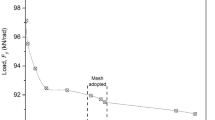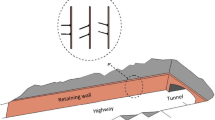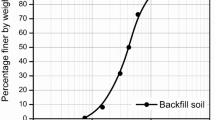Existing piles are commonly encountered during tunnel construction in congested underground areas. Tunnel-soil-pile interaction has recently attracted considerable research attention; however, previous studies have mainly focused on the pile response owing to small-scale tunnel excavation. In this study, we conducted a three-dimensional centrifuge test to investigate the deformation mechanisms of a pile group owing to largescale twin tunnel excavation. Pile group settlement increases almost linearly with tunnel advancement in response to a decrease of the tunneling-induced stress. A shorter distance between the monitoring point and new tunnel results in higher pile group settlement. A maximum pile group settlement of 0.23% of the tunnel diameter (D) is observed directly above the tunnel centerline upon completion of a single tunnel excavation. After twin tunnel excavation, the maximum pile group settlement increases to 0.32% D and the location of the maximum pile group settlement shifts to the centerline between the two tunnels. As the tunnel face approaches the monitoring section, the existing pile group tilts rapidly toward the tunnel face. Tilting of the existing pile group decreases as the tunnel face passes through the monitoring section. The measured tilting of the pile group reaches a maximum when the tunnel face is located directly beneath the monitoring section. This demonstrates the three-dimensional deformation mechanisms of the pile group owing to tunnel excavation. If the tunnel excavation is simplified to a two-dimensional problem, tilting of the pile group along the longitudinal tunnel direction is ignored, which is on the nonconservative side.
Similar content being viewed by others
References
J. W. Shi, C. W. W. Ng, and Y. H. Chen, “A simplified method to estimate three-dimensional tunnel responses to basement excavation,” Tunn. Undergr. Sp. Tech., 62: 53-63 (2017).
J. W. Shi, Y. Wang, and C. W. W. Ng, “Numerical parametric study of tunneling–induced joint rotation angle in jointed pipelines,” Can. Geotech. J., 53(12): 2058-2071 (2016).
S. W. Jacobsz, “The effects of tunneling on piled foundations,” Ph.D. thesis, University of Cambridge, Cambridge, UK (2002).
X. J. Yang, F. H. Deng, W. Nie, and G.G Li, “Study on effect of metro tunneling on carrying capacity of pile foundation,” Chin. J. Rock Mech. Eng., 25, 1290-1295 (2006).
Z. Li and M. S. Huang, “Analysis of settlement and internal forces of group pile due to tunneling,” Chin. J. Geotech. Eng., 29, 398-402 (2007).
N. Loganathan, H. G. Poulos, and D. P. Stewart, “Centrifuge model testing of tunnelling-induced ground and pile deformations,” Geotechnique, 50(3), 283-294 (2000).
S. Jacobsz, J. Standing, R. Mair, T. Hagiwara, and T. Sugiyama, “Centrifuge modeling of tunneling near driven piles,” Soils Found., 44(1), 49-56 (2004).
C. J. Lee and K. H. Chiang, “Responses of single piles to tunneling-induced soil movements in sandy ground,” Can. Geotech. J., 44(10), 1224-1241 (2007).
C. W. Ong, “Centrifuge model study of tunnel-soil-pile interaction in soft clay,” Ph.D. thesis, National University of Singapore, Singapore (2009).
S. K. Ma, H. Lu, K. S. Wong, C. W. W. Ng, and N. F. Zhao, “Three-dimensional centrifuge modelling of the effects of twin tunnelling on existing pile group in expansive clay,” Chin. J. Geotech. Eng., 35, 1337-1342 (2013).
A. M. Marshall and R. J. Mair, “Tunneling beneath driven or jacked end bearing piles in sand,” Can. Geotech. J., 48(12), 1757-1771 (2011).
C. W. W. Ng and H. Lu, “Effects of construction sequence of twin tunnelling at different depth on a single pile,” Can. Geotech. J., 51(2), 173-183 (2013).
C. W. W. Ng, H. Lu, and S. Y. Peng, “Three-dimensional centrifuge modelling of twin tunnelling effects on an existing pile,” Tunn. Undergr. Sp. Tech., 35, 189-199 (2013).
Y. Hong, M. A Soomro, and C. W. W. Ng, “Settlement and load transfer mechanism of a pile group due to side-byside twin tunnelling,” Comput. Geotech., 64, 105-119 (2015).
J. W. Shi, J. Q. Wei, C. W. W. Ng, and H. Lu, “Stress transfer mechanisms and settlement of a floating pile due to adjacent multi-propped deep excavation in dry sand,” Comput. Geotech., 116, 103216 (2019).
J. W. Shi, Y. Wang, and C. W. W. Ng, “Three-dimensional centrifuge modeling of ground and pipeline response to tunnel excavation,” J. Geotech. Geoenviron. Eng., 142(11), 04016054 (2016).
J. W. Shi, Z. Z. Fu, and W. L. Guo, “Investigation of geometric effects on three-dimensional tunnel deformation mechanisms due to basement excavation,” Comput. Geotech., 106, 108-116 (2019).
W. Shi, C. Ding, C. W. W. Ng, H. Lu, and L. Chen, “Effects of overconsolidation ratio on tunnel responses due to overlying basement excavation in clay, “ Tunn. Undergr. Sp. Tech., 97, 103247 (2020).
S. Yang, B. Leshchinsky, K. Cui, F. Zhang, and Y.F. Gao, “Influence of failure mechanism on seismic bearing capacity factors for shallow foundations near slopes,” Geotechnique, DOI: https://doi.org/10.1680/jgeot.19.P.329 (2020).
J. He, Y.F. Gao, Z.X. Gu, J. Chu, and L.Y. Wang, “Characterization of crude bacterial urease for CaCO3 precipitation and cementation of silty sand,” J. Mater. Civil Eng., 32(5), 04020071 (2020).
Author information
Authors and Affiliations
Corresponding author
Additional information
Translated from Osnovaniya, Fundamenty i Mekhanika Gruntov, No. 6, November-December, 2021.
Rights and permissions
About this article
Cite this article
Zhang, Y., Ding, C., Lu, H. et al. Effects of Large-Scale Twin Tunnel Excavation on an Existing Pile Group: Three-Dimensional Centrifuge Modeling. Soil Mech Found Eng 58, 500–506 (2022). https://doi.org/10.1007/s11204-022-09772-0
Published:
Issue Date:
DOI: https://doi.org/10.1007/s11204-022-09772-0




